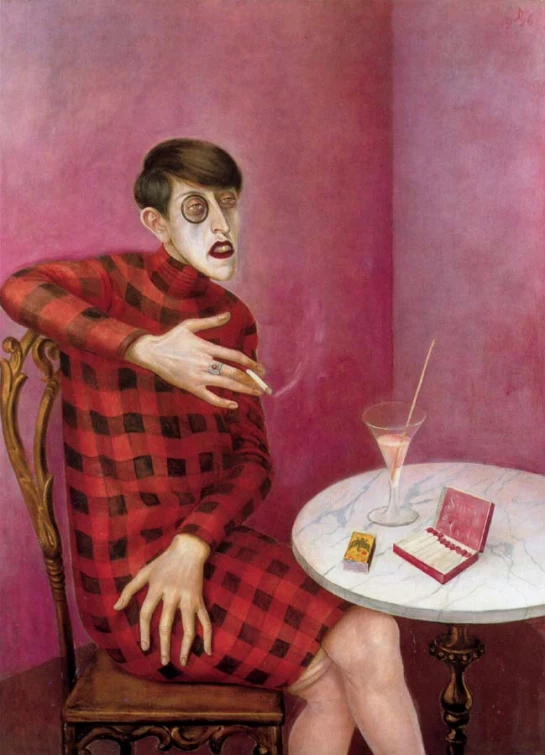In the Portrait of the Journalist Sylvia von Harden, Otto Dix is demonstrating the “new woman” that was emerging in Germany during the 1920’s. His demonstration is showing the social changes that were present during this time in Germany. The new woman, or “neue frau” in German, was a woman who left all previous conventions of what a woman was supposed to be behind. This new woman smoked, drank, was career oriented, and didn’t care much about marriage or creating a family. This was not the way in which women acted before this time. I will show how Dix’s painting encapsulates the idea of the new woman in Germany and the societal shifts that were happening during this time.
In the portrait, Dix has portrayed Sylvia in a mannish way. Her posture is slumped and it is obvious that she is not trying to look beautiful. She is making an ugly grimacing face instead of smiling. She is painted sitting at a table in a café with a cigarette in her right hand and a cocktail sitting on the table. We can tell she is not very concerned with the way that she looks. Evidence for this is found by looking at her stockings, which are falling down below the line of her dress. The clothes that she is wearing are also not very flattering. The dress does not show very much of her womanly figure. One of her hands is residing over the place on her body here her breasts should be while the other hand is resting over her pelvic region. By positioning Sylvia in this manner, Dix is covering up all of the physical attributes that make her a woman. Sylvia is also sporting a rather masculine haircut. The only real evidence that the person in this portrait is a woman is that she is wearing a dress. All of the manly features that Sylvia is displaying contrast greatly with the chair that she is sitting in. The chair is very ornate, beautiful and flowery. This juxtaposition of the way that Sylvia looks serves as a comparison between the way women were thought of before this time period and their new position in society.
More evidence that Dix is portraying Sylvia as the new woman is by looking at her hands. They are very large in proportion to her body and seem manly. Also by looking at Sylvia’s hands we notice that there is no wedding ring. Therefore she is single and uninhibited by the responsibilities of a husband or children. Since she is not married, she has time to sit in cafes smoking and drinking instead of caring for her household.
Sylvia is wearing a monocle in her right eye. Monocles are commonly associated with men and it is strange to find a woman sporting one. She is wearing a monocle in order to better see what she is doing. The monocle conveys a sense that she is concentrated on her career and has no time to focus on other more mundane things. A career oriented woman was an aspect of the new woman that was found in Germany in the 1920’s and Dix could have portrayed her with a monocle to show the shift that was occurring in German society. We also see that Sylvia is seated at a table for one. This could be further evidence that she is concentrating on her work and too preoccupied by it to be bothered by the company of others.
Dix’s painting of Sylvia von Harden is a painting of the new woman that was emerging in Germany. In essence, it is a picture of the new Germany in the post world war one era.
